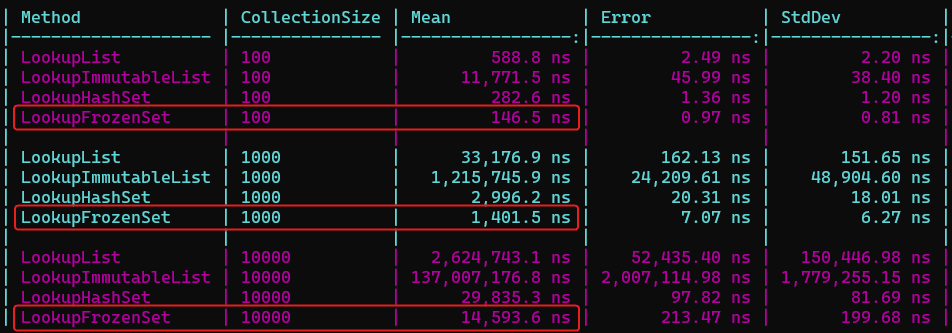.NET 8 introduced Frozen Collections.
.NET already has Immutable and ReadOnly Collections, so what are the benefits of Frozen Collections?
Let’s find out!
Frozen Collections
First, look at the new types FrozenSet<T> and FrozenDictionary<TKey, TValue>.
These are abstract types, so you can not create instances of them. However, there are extension methods for doing that.
List<int> numbers = [1, 2, 3, 4, 5];
Dictionary<int, string> dictionary = [];
dictionary.Add(1, "One");
dictionary.Add(2, "Two");
FrozenSet<int> frozenNumbers = numbers.ToFrozenSet();
FrozenDictionary<int, string> frozenDict = dictionary.ToFrozenDictionary();After collections freeze, you can’t modify their values.
The key difference is that Frozen Collections are optimized for fast lookup and enumeration. However, freezing has a relatively high cost to create such a collection.
That’s why Frozen Collections are significant for scenarios when the creation of a collection is very infrequently but is used very frequently at run-time.
We’ll see it in the benchmarks below.
But before going further, I’d like to point out one significant difference between the ReadOnly collection and the Immutable and Frozen collection.
Look at the code below.
List<int> numbers = [1, 2, 3, 4, 5];
FrozenSet<int> frozenNumbers = numbers.ToFrozenSet();
ImmutableList<int> immutableNumbers = numbers.ToImmutableList();
ReadOnlyCollection<int> readOnlyNumbers = numbers.AsReadOnly();
numbers.Add(6);
Console.WriteLine($"Frozen: {string.Join(", ", frozenNumbers)}");
Console.WriteLine($"Immutable: {string.Join(", ", immutableNumbers)}");
Console.WriteLine($"ReadOnly: {string.Join(", ", readOnlyNumbers)}");
// Frozen: 1, 2, 3, 4, 5
// Immutable: 1, 2, 3, 4, 5
// ReadOnly: 1, 2, 3, 4, 5, 6The ReadOnly collection is a wrapper for the existing collection. You can’t modify the wrapper but can change the existing collection.
Lookup Benchmarks
Let’s check the benchmarks for looking up through different collections.
As a tool, I use the beloved BenchmarkDotNet.
The setup for benchmarking looks the following.
[Params(100, 1000, 10_000)]
public int CollectionSize { get; set; }
private List<int> _list;
private ImmutableList<int> _immutableList;
private HashSet<int> _hashSet;
private FrozenSet<int> _frozenSet;
[GlobalSetup]
public void SetUp()
{
_list = Enumerable.Range(0, CollectionSize).ToList();
_immutableList = Enumerable.Range(0, CollectionSize).ToImmutableList();
_hashSet = Enumerable.Range(0, CollectionSize).ToHashSet();
_frozenSet = Enumerable.Range(0, CollectionSize).ToFrozenSet();
}I’ve added HashSet for comparison. The benchmarks test the collections with 100, 1000, and 10 000 elements.
The benchmarks look as follows.
[Benchmark(Baseline = true)]
public void LookupList()
{
for (var i = 0; i < CollectionSize; i++)
_ = _list.Contains(i);
}
[Benchmark]
public void LookupImmutableList()
{
for (var i = 0; i < CollectionSize; i++)
_ = _immutableList.Contains(i);
}
[Benchmark]
public void LookupHashSet()
{
for (var i = 0; i < CollectionSize; i++)
_ = _hashSet.Contains(i);
}
[Benchmark]
public void LookupFrozenSet()
{
for (var i = 0; i < CollectionSize; i++)
_ = _frozenSet.Contains(i);
}Results:

As you can see, the FrozenSet wins even HashSet.
Creation Benchmarks
Let’s find out how much FrozenSet creation costs compared to other collections.
public class CreationBenchmarks
{
private readonly int[] Numbers = Enumerable.Range(0, 1000).ToArray();
[Benchmark(Baseline = true)]
public List<int> ToList() => Numbers.ToList();
[Benchmark]
public FrozenSet<int> ToFrozenSet() => Numbers.ToFrozenSet();
[Benchmark]
public HashSet<int> ToHashSet() => Numbers.ToHashSet();
}Results:

Here FrozenSet loses.
Summary
In this post, we discovered that Frozen Collections are immutable and read-only, optimized for fast lookup and enumeration.
They’re suitable for scenarios where the collection is created once and used frequently in long-lived services.
The benchmarks are available on my GitHub.


Great 👍